As a responsible dog owner, ensuring the well-being and safety of your furry companion is of utmost importance. One key aspect of canine care is selecting and fitting the appropriate collar for your dog. The question that often arises is: How tight should my dog’s collar be? For a perfect fit, the collar should not be too tight or too loose. In this blog post, we will discuss the considerations and guidelines for finding the perfect fit to keep your dog comfortable, safe, and secure.
Types of Collar
There are several types of dog collars, each designed to serve a specific function. The following are some common dog collar types.
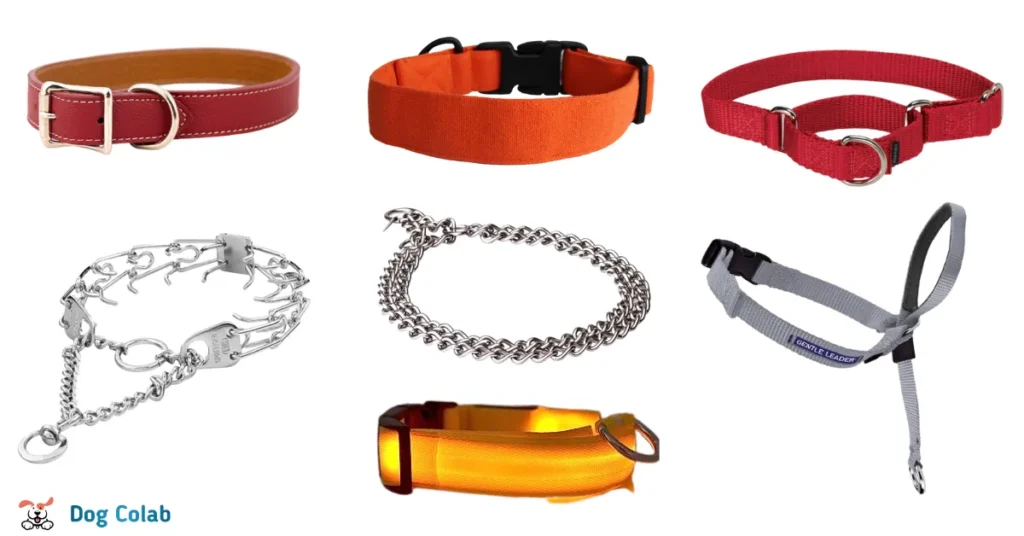
1. Fabric Collars
These collars are typically made of nylon or fabrics. They are lightweight and come in various colors and patterns.
2. Leather Collars
The durability and classic appearance of leather collars makes them a popular choice. They are often preferred for larger, stronger dogs due to their strength.
3. Martingale Collars
A Martingale collar prevents dogs from slipping out of their collars. They have a loop that tightens when the dog pulls, providing gentle control without choking.
4. LED or Reflective Collar
These collars have built-in LED lights or reflective materials to improve visibility during low-light conditions. They are especially useful for walking dogs at night or in areas with heavy traffic.
5. Metal Collars
Metal collars are typically made of stainless steel or chrome. They are commonly used for working or training dogs.
6. Prong Collar
Similar to a choke chain, a prong collar, also called a pinch collar, has metal prongs that apply pressure when the leash is pulled. The prong collar is also used for training.
7. Electronic Collars
Electronic collars, also known as e-collars or shock collars, are designed to deliver an electronic stimulus, such as a vibration or static shock, to the dog.
8. Chain Collars
Chain collars, also known as choke chains or slip chains, are made of metal links. They tighten around the dog’s neck when pulled, providing a correction.
9. Head Collars
Head collars are designed to fit around the dog’s muzzle and head. They provide control by redirecting the dog’s attention and can be useful for dogs that have behavior issues or that pull.
10. Slip Collar
Slip collars, also known as slip leads or choke collars, are made of a continuous loop of material that tightens when pulled. They are often used for training or control during walks.
11. Buckle Collar
Buckle collars have a buckle closure similar to a belt. They are easy to put on and take off and come in various materials, including fabric, leather, and nylon.
Dog Collar Sizes
The sizes generally correspond to the circumference of the dog’s neck, and here is a guideline for each size.

1. Extra small
Typically for dogs with a neck circumference of around 6 to 10 inches (15 to 25 cm).
2. Small
Usually fits dogs with a neck circumference of approximately 10 to 14 inches (25 to 35 cm).
3. Medium
Generally suitable for dogs with a neck circumference of about 14 to 18 inches (35 to 45 cm).
4. Large
Typically designed for dogs with a neck circumference of around 18 to 22 inches (45 to 55 cm).
5. Extra Large
Typically for dogs with a neck circumference of approximately 22 inches (55 cm) or larger.
How To Measure For a Dog Collar?
Measuring a dog collar is an important step to ensure a proper fit and comfort for your furry friend. Here’s a step-by-step guide on how to properly fit a dog collar.
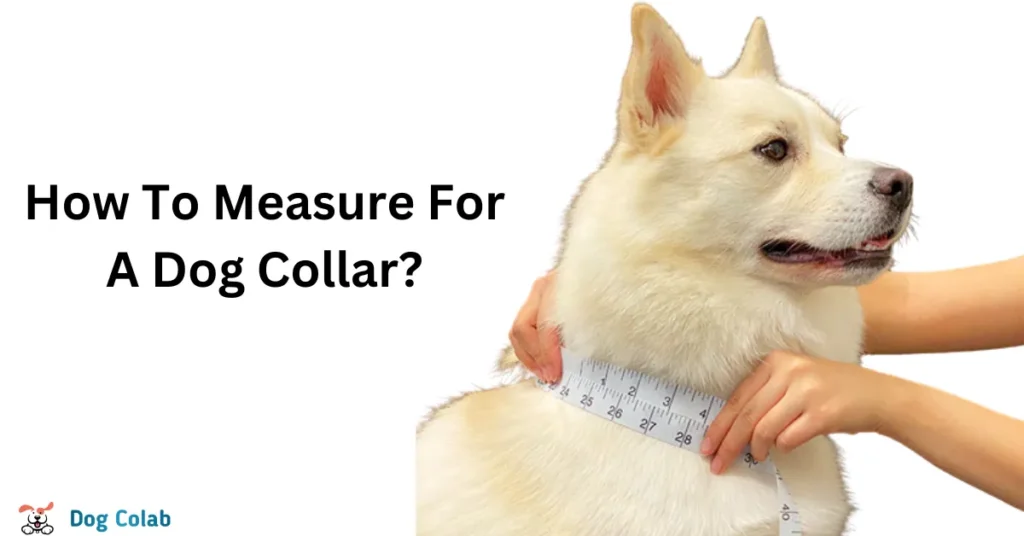
1. Gather the Necessary Materials
Before you begin measuring for a dog collar, make sure you have the following materials ready:
- Flexible measuring tape or a piece of string.
- Paper and pen to record the measurements.
2. Prepare Your Dog
Ensure your dog is calm and relaxed before measuring for a collar. By doing this, the process will be easier and more accurate.
3. Measure the Dog’s Neck Circumference
Using the flexible measuring tape or string for finding how should a dog collar fit and gently wrap it around the base of your dog’s neck, where the collar would normally sit. Make sure the tape or string is snug but not too tight. Note the measurement in inches or centimeters.
4. Add the Desired Collar Length
Decide on the desired length for the collar. It is recommended to add an extra inch or two (2-5 cm) to the measurement to ensure a comfortable fit. This will allow room for adjustments and prevent the collar from being too tight.
5. Determine the Collar Size
Take the measurement from step 3 (neck circumference) and add the desired collar length from step 4. This final measurement will determine the appropriate collar size for your dog.
7. Size Chart or Manufacturer Guidelines
Different collar manufacturers may have their own sizing guidelines, so it’s important to refer to their specific instructions. Look for a size chart provided by the collar manufacturer.
8. Select the Appropriate Collar Size
Using the measurements and guidelines obtained, select the collar size that matches your dog’s measurements. Collars typically come in sizes like small, medium, large, and extra-large. Ensure that the chosen size corresponds to your dog’s neck measurement.
9. Check the Fit
Once you have the collar, place it around your dog’s neck and fasten it. Ensure that it is snug enough to stay in place but not too tight to restrict your dog’s movement or cause discomfort. The collar should be able to fit two fingers between your dog’s neck and the collar.
How Tight Should My Dog’s Collar Be?
When it comes to fitting your dog’s collar, it is important to strike a balance between ensuring their comfort and safety. The collar should be snug enough to prevent it from slipping off but not so tight that it causes discomfort or restricts your dog’s movement or breathing. Here are some guidelines to help you determine how tight should a collar be on a dog.
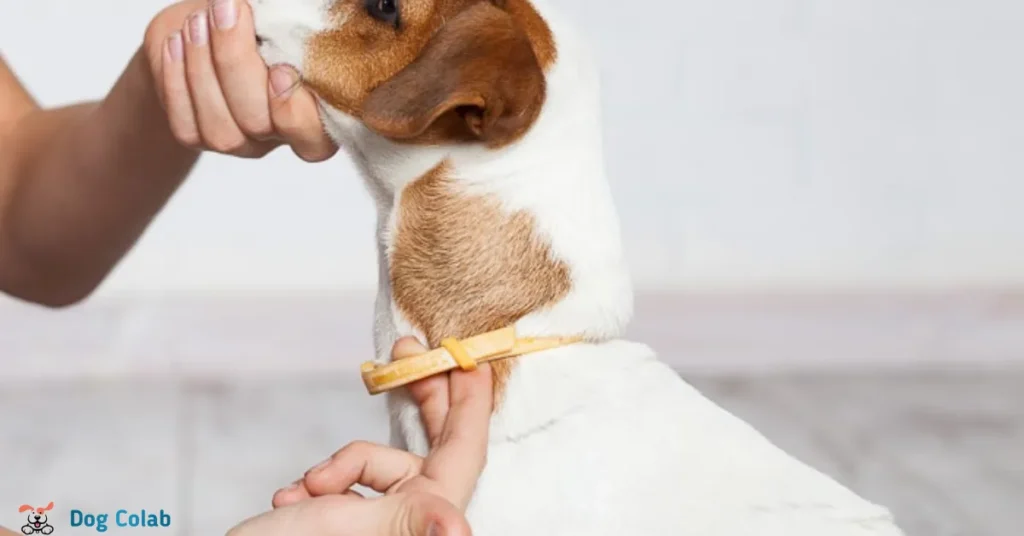
1. Two-Finger Role
Place two fingers (usually your index and middle finger) between the collar and your dog’s neck. You should be able to slide the fingers easily, but there shouldn’t be too much excess space.
2. Comfortable Breathing
Make sure the collar is loose enough to allow your dog to breathe comfortably. Check for any signs of choking or labored breathing.
3. Mobility
Your dog should be able to move their head, shoulders, and front legs freely without any restriction from the collar. Ensure the collar is not too tight to hinder their movement.
4. Safety
Ensure that the collar is secure enough to prevent your dog from slipping out of it accidentally. It should be snug but not so tight that it causes discomfort or potential injury.
How Loose Should a Dog Collar Be?
The general rule of thumb is that a dog collar should be loose enough to allow you to comfortably fit two fingers between the collar and your dog’s neck. This ensures that the collar is not too tight, which can be uncomfortable or even harmful for your furry friend.

A collar that is too loose poses risks as well. If it’s too easy for your dog to slip out of the collar, they could potentially escape and find themselves in dangerous situations.
Finding how should a dog’s collar fit also depends on the type of collar you’re using. For example, a flat buckle collar should have enough room to slide two fingers underneath, while a martingale collar should fit snugly around the neck without choking the dog.
How Tight Should a Shock Collar Be?
A shock collar should be snug but not excessively tight around a dog’s neck. It should be fitted so that you can slide two fingers comfortably between the collar and the dog’s skin. This ensures that the collar is secure enough to prevent slipping off, while also allowing for proper blood circulation and minimizing discomfort or potential injury.

It’s crucial to follow the manufacturer’s guidelines and instructions for fitting and using the shock collar correctly to ensure the safety and well-being of the dog.
Why a Properly Fitting Collar Is Important?
A proper dog collar fit is of utmost importance when it comes to the well-being and safety of a pet. Collars serve multiple purposes, including identification, restraint, and control, but if they don’t fit correctly, they can pose serious risks.

Firstly, a properly fitting collar ensures that identification tags and contact information are securely attached to the pet. This becomes crucial in case the pet wanders off or gets lost, allowing for a swift and safe return to its owner.
Secondly, a collar that fits snugly but comfortably around the pet’s neck prevents accidental slipping or escaping. A loose collar may enable a crafty pet to slip out of it, potentially exposing them to dangerous situations like traffic or encounters with aggressive animals.
Recommended Also Read:- Should dog wear the collar all the time.
Risks of a Dog Collar Being Too Tight
A dog collar that is too tight can pose several risks to the health and well-being of a dog. Here are some potential risks.
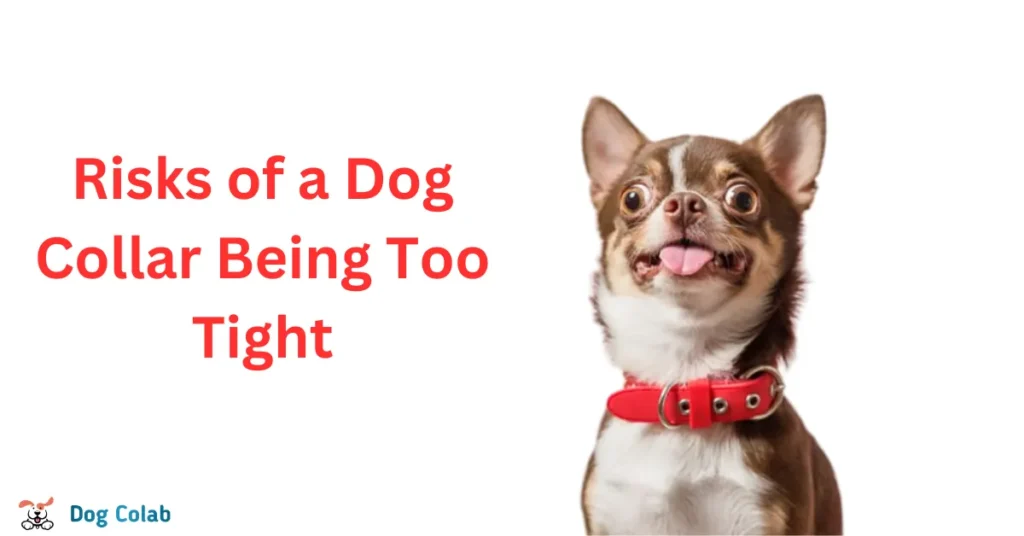
1. Discomfort and Pain
A tight collar can cause discomfort and pain for the dog. It can rub against the skin, leading to irritation, chafing, and even sores. This can be particularly problematic if the collar is made of rough or abrasive material.
2. Restricted Breathing
A collar that is too tight can put pressure on the dog’s throat and restrict its breathing. This is especially concerning for breeds with shorter snouts, such as Bulldogs and Pugs, as they already have difficulty breathing due to their anatomy.
3. Injuries and Damage to the Neck
Excessive pressure from a tight collar can cause damage to the delicate structures in the neck, including the trachea, esophagus, blood vessels, and nerves. It can also lead to muscle strain and discomfort.
4. Difficulty Swallowing
A collar that is too tight may hinder the dog’s ability to swallow properly. This can result in regurgitation, choking, or difficulty eating and drinking.
5. Increased Stress and Anxiety
Constant discomfort and restriction can contribute to increased stress and anxiety in dogs. It can negatively impact their overall well-being and potentially lead to behavioral issues.
The Dangers of a Dog Collar Being Too Loose
There are risks associated with having a dog collar too loose. Here are some potential risks.

1. Accidental Escape
If a dog’s collar is too loose, there is an increased risk of the dog slipping out of the collar and escaping. This can be especially dangerous if the dog is in an unfamiliar or unsafe environment, as they may run off and get lost or be exposed to various hazards.
2. Injuries During Walks
A loose collar can cause the leash to get tangled or caught on objects, leading to potential injuries for the dog. For example, if the leash gets snagged on a tree branch or fence, the dog may jerk or struggle to free itself, which can result in neck or throat injuries.
3. Choking Hazards
If the collar is excessively loose, there is a risk that the dog’s paw or lower jaw may get caught in the collar, leading to choking or strangulation. This can happen if the dog tries to scratch or bite at the collar and ends up getting entangled.
4. Loss of Identification Tags
If the dog collar too loose, there is an increased chance of losing the dog’s identification tags. This can make it difficult for others to identify and return the dog if they happen to get lost.
How To Know If Dog Collar Is To Tight? (4 Signs)
When determining if a dog collar is too tight, there are a few signs to look out for.
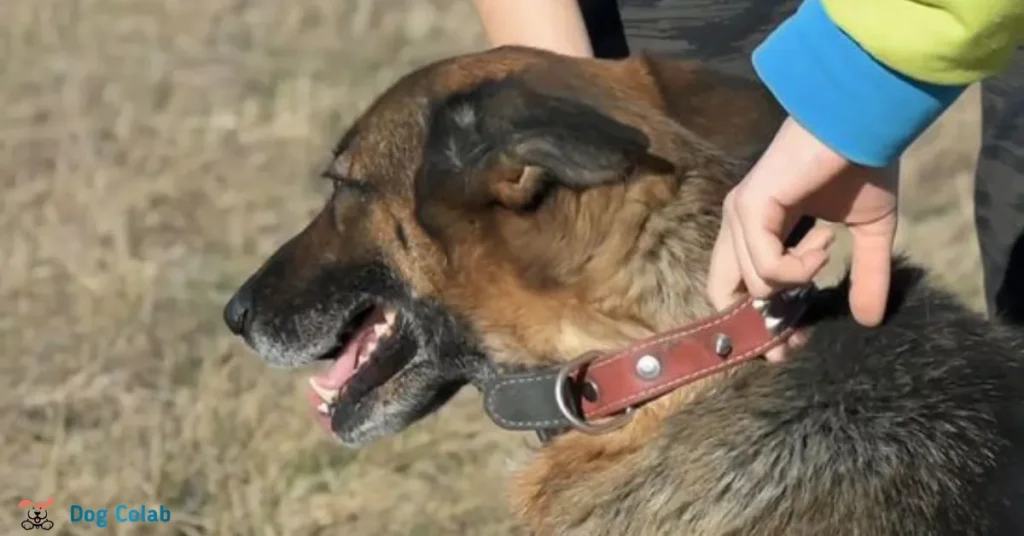
1. Difficulty Breathing or Excessive Panting
Overly tight collars can restrict your dog’s airflow, making it difficult for him to breathe.
2. Fur or Skin Irritation
Check for any signs of irritation or hair loss around the neck area. A collar that is too tight can rub against the skin, causing discomfort, redness, or sores.
3. Difficulty Swallowing or Eating
If the collar is too tight, it may interfere with your dog’s ability to swallow food or water.
4. Unusual Behavior or Discomfort
Keep an eye out for signs of discomfort or unusual dog behavior when your dog is wearing the collar. They may scratch at it, try to remove it with their paws, or exhibit signs of distress.
Regular Check Your Dog Collar
Regularly checking your dog’s collar is essential to ensure their safety and comfort. Here is a step-by-step guide on how to perform a regular check on the collar.

1. Visual Inspection
Take a close look at your dog’s collar to assess its condition. Look for any signs of wear and tear, such as frayed edges, loose threads, or cracks in the material. Ensure that the collar is still in good overall condition.
2. Size and Fit
Verify that the collar is the right size for your dog. Puppies and adolescent dogs may outgrow their collars, so make sure it is not too tight or too loose. The two-finger rule can help you determine if the collar is properly fitted. You should be able to fit two fingers easily between the collar and your canine’s neck.
3. Comfort and Irritation
Observe your dog’s behavior for any signs of discomfort or irritation caused by the collar. Check if the collar is rubbing against the skin, causing redness or hair loss. The collar should not be too tight, as it may restrict your dog’s movement or cause discomfort.
4. Construction and Fastenings
Examine the collar’s construction to ensure it is sturdy and secure. Check if the joints and fastenings, such as buckles or clips, are tight and not loose. The collar should be able to withstand pulling and tugging without breaking or coming apart.
5. Special Collars
If your dog uses an electronic collar or GPS collar, follow the manufacturer’s recommendations for maintenance and inspection. Regularly check the battery status of electronic collars and ensure that the construction is intact.
Conclusion “How Tight Should My Dog’s Collar Be”
Finding the perfect fit for your dog’s collar requires careful consideration of their breed, size, comfort, and safety. Remember that a proper dog collar fit
should provide identification, control, and security while allowing your dog to move freely and breathe comfortably. Regularly check and adjust the collar fit as your dog grows or their weight changes. By prioritizing your dog’s well-being and taking the time to find the right fit, you can ensure that your furry friend stays happy, healthy, and safe throughout their life.
NOTE:- You can find more information by clicking this link.
FAQs
1. Should dogs wear collars 24 7?
No, dogs should not wear collars 24/7. They should have regular breaks from wearing collars to allow their skin to breathe and to prevent discomfort or potential injury.
2. Do dogs sleep with their collars on?
It is generally recommended to remove a dog’s collar before they sleep to ensure their safety and comfort.
3. Do dogs like wearing collars all the time?
Some dogs may not mind wearing collars all the time, but it ultimately depends on the individual dog’s comfort level and the type of collar used.
4. Are collars uncomfy for dogs?
Collars can be uncomfortable for some dogs, especially if they are ill-fitting or constantly pulled. It’s important to choose the right size and fit, and use positive reinforcement training for collar acceptance.
5. How do I make my dog comfortable with a collar?
Gradually introduce the collar to your dog by letting them sniff and investigate it. Reward positive behavior and provide treats. Increase wearing time gradually to help them get comfortable.
